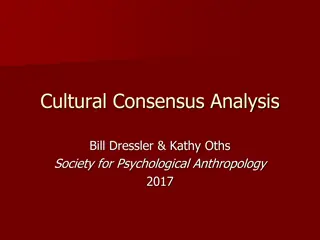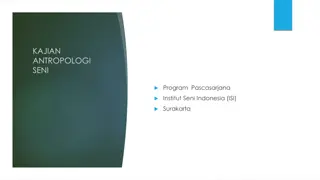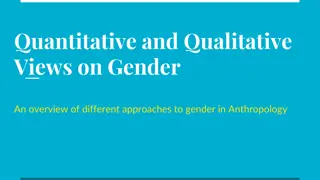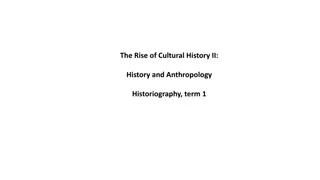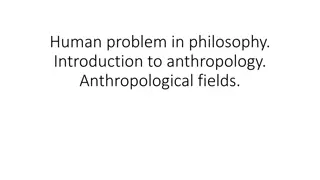Understanding Ethnographic Research in Anthropology
Ethnographic research in anthropology focuses on studying cultures through direct observation in natural environments. It aims to gain insights into how users interact with their surroundings, providing in-depth understanding of social interactions, behaviors, and perspectives. Methods include direct observation, diary studies, and more, conducted over varying durations. Documentary analysis complements ethnography by examining historical data sources like records, books, and films to further enrich cultural understanding.
Download Presentation

Please find below an Image/Link to download the presentation.
The content on the website is provided AS IS for your information and personal use only. It may not be sold, licensed, or shared on other websites without obtaining consent from the author. Download presentation by click this link. If you encounter any issues during the download, it is possible that the publisher has removed the file from their server.
E N D
Presentation Transcript
Ethnographical research Disciplinary root anthropology Central questions-what is the culture of this group of people
What is ethnography research Ethnography is a study through direct observation of users in their natural environment rather than in a lab. The objective of this type of research is to gain insights into how users interact with things in their natural environment.
The aim of ethnographic research Ethnography is a qualitative research study looking at the social interaction of users in a given environment. This research provides an in-depth insight into the user s views and actions along with the sights and sounds they encounter during their day. It provides the researcher with an understanding of how those users see the world and how they interact with everything around them. Ethnography methods include direct observation, diary studies, video recordings, photography and devices that a person uses throughout the day. Observations can be made anywhere from the user s workplace, their home or while they are out with family and friends. The length of the studies can vary depending on the research that is being conducted. They can range from a couple of hours of observation, to studies that last several months.
Ethnography in addition to being a theoretical perspective is a method of carrying out qualitative observational research. The basic purpose of ethnographic research is to determine the physical and social environment in which the individuals under live, study, work and so forth.
The roots of anthropology includes the cultural phenomenon. Document and content analysis is concerned with the explanation of status of some phenomena at particular time or its development over a period of time .it serves as useful purpose in adding knowledge to field of enquiry and in explaining certain social events
In documentary analysis the source of data may be Records, reports, printed forms ,letters,autobiographies,diaries,composition s,themes and other academic works,books,periodicals,bulletins ,catellogues,syllabi,court decisions,pictures ,films and cartoons.
When using documentary sources one must bear in mind that data appearing in print are not necessarily trustworthy Authenticity and validity of its content is crucial. It is the researchers obligation to to establish trustworthiness of all data that he or she draws from documentary sources.
Topics To describe prevailing practices or conditions To discover the relative importance of or interest in certain topics and problems To discover the difficulty of presentation in textbooks or in other publications To analye types of errors in students work.
Ethnographic studies Also known as cultural anthropology or naturalistic inquiry. It consisted of participant observation ,conversation, to study cultural characteristics of primitive people These groups were small in number ,geographically and culturally isolated with little specialization in social function with simple economies and technology
Cultural features as language ,marriage and family life ,child rearing practices ,social relations and rules of conduct ,political institution ,methods of production were analyzed.
Ethnographic methods of research have used to investigate such problems as Students leadership role in an urban racial integrated high school Pupil teacher relationship in Sunderban High school. Social relationships in class of emotionally disturbed children Staff parent interaction in an Individualized Education Plan staffing.
Data collection techniques Observation Interview The combination of the two
Observation can be of the setting or physical environment ,social interactions, physical activities ,non verbal communications ,planned and unplanned activities and interactions
Interviews The purpose of interviewing is to find out what is in or someone else mind. Interview data can easily become biased and misleading if the person being interviewed is aware of the perspective of the interviewer Interview range from quite informal and completely open ended to very formal with the questions predetermined and asked in a standard manner.
Data analysis The first step in analyzing qualitative research involves organizing the data through observations, interviews and documents. The method of organizing data will differ depending upon the research strategy and data collection techniques used,
Second stage is data analysis ,description, The researcher describes the various pertinent aspects of the study including the setting Final step is interpretation involves explaining the findings,answerinwhy,questions,attaching significance to particular results and putting patterns into an analytic framework
The interpretation of qualitative research data is more dependent on the researcher background ,skills, biases and knowledge than conclusion drawn from quantitative research which are derived more directly from the numerical analysis of data.
Advantages of ethnographic research Ability to see first-hand how users interact with technology in their natural environment Identify unexpected issues that you might not have encountered in a usability test Opportunity to test new product ideas before they are released to the market to see what demand is like
Disadvantages of Ethnography research Because there is a greater insight into the user it takes much longer to generate and analyse all the findings. Short studies may not get a user acting naturally as they are aware of the researchers present. The cost of conducting ethnographic studies is typically much higher than conducting a usability test.
summary Qualitative research focuses on in depth interviews ,observations and document analysis Qualitative research interprets data without numerical analysis The most common forms of qualitative research were document or content analysis ,case studies and ethnography. Steps of qualitative data analysis are-data organization, description of data and interpretation of data.
Conclusion Ethnographic studies are a good way to really understand your users and the challenges they may face while going about their everyday lives. The research will give you insights to your users that you may not have seen if they were in a lab being asked to complete a task. However, Ethnographic studies can be costly and time consuming, so making sure that you get the research method right is crucial to making sure that you are getting the research questions answered. Having conducted a study, you then need to present your findings back in an informative and meaningful way that will allow teams to use the information to make informed changes, making sure that your own opinions have not come into the findings.
Thanks Dr Kalpana Patni Lakhera Assistant Professor,Education Uttarakhand Open University ,Haldwani















